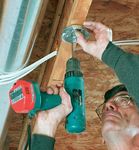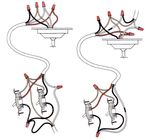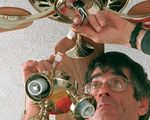Choosing and Installing a Ceiling Fan - The right fan in the right location will keep you comfortable in winter as well as in summer
←
→
Page content transcription
If your browser does not render page correctly, please read the page content below
Choosing and Installing a Ceiling Fan The right fan in the right location will keep you comfortable in winter as well as in summer BY FERNANDO PAGÉS RUIZ
ere on the Nebraska plains, tem- Wind chill is so effective that breezes stirred room or a master bedroom (sidebar below).
H peratures can swing from blister-
ing heat to unbearable cold with
by a ceiling fan can make you feel as much as
8°F cooler. Studies have shown that a well-
For cooling purposes, I look for a house’s hot
spots, such as a sunroom or a kitchen break-
each passing storm front. As a homebuilder, placed ceiling fan can keep most people com- fast nook. To help balance the air tempera-
I find it difficult to furnish customers with fortable (without air conditioning) in temper- tures in the winter, I place fans in rooms with
an evenly balanced heating and air-condi- atures as high as 86°F. high ceilings and over stairwells. I also place
tioning system. Fortunately, I’ve learned that In cold weather, the wind-chill effect dis- ceiling fans near woodstoves or gas fire-
ceiling fans can do a lot to help maintain courages the use of a ceiling fan. That’s why places because the fans will drive warm air
comfortable temperatures throughout a manufacturers provide a built-in reverse into the rest of the structure, thus warming it
house. In warm weather, ceiling fans offer an switch to spin fan blades clockwise, pulling more efficiently.
effective, low-cost alternative to air condi- air up gently toward the ceiling. This upward Ceiling height is always a consideration
tioning. In cold weather, ceiling fans im- draft helps to mix warm air at ceiling level when I’m placing a fan in a house. For safe
prove air circulation for uniform heat distri- with colder air near the floor without creating operation, the fan’s blades must hang at least
bution. But any fan in any odd location won’t noticeable breeze. In a family room with a 7 ft. above the floor and not less than 18 in.
do. As with most appliances, you’ll have few- 12-ft. cathedral ceiling, for example, temper- from an adjacent wall or sloping ceiling. The
er headaches when you buy a quality product, atures can vary as much as 15°F from floor optimum height for fan blades is between
install it correctly and learn how to use it. to ceiling. A properly sized ceiling fan can 8 ft. and 10 ft. above the floor. This fan
reduce this stratification to as little as 2°F. height promotes the best airflow both sum-
Ceiling fans only make you feel cooler mer and winter.
Our bodies release excess heat by evaporating Fans belong where the people are In rooms with high ceilings, I use an exten-
sweat. Air movement speeds up this cooling When locating fans in a home, I pick rooms sion rod to lower the blades to the proper
process, creating what’s known as wind chill. where people congregate, such as a family height (photo facing page). Extension rods
Size fans according to
Family room = 600 sq. ft.
occupied space
Occupied area = 200 sq. ft. Ceiling fans range from 24 in. to 60 in. in dia. Fan
manufacturers usually correlate fan size with
room area. Some label their product’s cubic-foot-
per-minute capacity (cfm) on the carton, making
it easy to run air-volume calculations. Generally,
high-quality 36-in. ceiling fans move between
2500 cfm and 4000 cfm; 48-in. fans move 4000
cfm to 8000 cfm. A quick calculation of room vol-
A 52-in. fan is sufficient ume tells me what size fan I should need.
for occupied area.
The volume of the room is not always the most
important consideration, however. Often (espe-
cially for cooling purposes), I downsize a ceiling
fan to fit the area of a room that’s typically occu-
pied. The occupants of a 600-sq. ft. family room,
for example, might be better served by a smaller
fan if the furniture arrangement is contained
within a 200-sq. ft. space (drawing left).
Because the ceiling fan will still affect air out-
side the occupied space, I don’t use the manufac-
turer’s room-area numbers when sizing a fan to
cool just an occupied space. As a rule of thumb, I
divide the square footage of the occupied space
by four to determine the diameter (in inches) of
the proper ceiling fan. Thus the 200 sq. ft. of occu-
pied space in the above example would be ade-
quately served by a 52-in. ceiling fan.
—F. P. R.
Drawings: Paul Perreault OCTOBER/NOVEMBER 2001 99Wood and steel support ceiling fan. Mount-
ed on the flat and secured to the joists with
3-in. screws, a recessed 2x4 block holds up
the 2-in. deep metal box that supports the
ceiling fan.
When it absolutely, positively has to hang
from the joist. If the layout places a ceiling
fan directly beneath a joist, a 1⁄2-in. deep
pancake box provides unobtrusive support.
Hot to switches
T W O W AY S Ground Incoming
TO WIRE A Hot to fan Hot to light power
FAN/LIGHT
Hot to fan
C O M B I N AT I O N Neutral
Running a three-conductor
cable (12-3 NM with
ground) between the ceiling
box and the switch makes it Three-conductor
possible to operate the fan cable Hot to light
motor and the light kit
from separate wall Three-conductor
switches. cable
Ground
Fan switch
Fan switch
Neutral Light switch
White hot
(taped black)
Light switch
The white is
Incoming taped black to
Hot power indicate it’s hot.
Power brought to switch, Power brought to fan,
then to fan then to switch
100 FINE HOMEBUILDING Drawing: Excerpted from Safe Home Wiring Projects by Rex Cauldwell (The Taunton Press, 1997)for ceiling fans are available in 6-in. incre-
ments, up to 8 ft. in length.
The best fans are like John Wayne: Remodeling bracket makes it easy
strong and silent to put a ceiling fan in a finished room
I don’t want my customers calling me to
complain about noisy fans, so I buy only fans I won’t hang a fan from an existing ceiling box unless it’s a metal box firmly at-
that have sealed, precision steel bearings and tached to solid framing. If such a box isn’t available and I can’t install blocking
maintenance-free motors (sidebar p. 103). from an attic, I like to hang the outlet box from an expandable fan-mounting
When it comes to noise, the switching brace (Pass & Seymour/Legrand; 800-223-4185). This device works like a pres-
mechanism is almost as important as the sure-fit shower rod. After cutting a 4-in. dia. hole for the ceiling box, I insert
quality of the motor. Most fan motors have a
the brace (top photo) and set its feet atop the drywall. A twist of my wrist ex-
three-speed switch built into the housing,
which is operated by a pull chain. pands the brace to reach the joists on each side. A little added torque drives
Should customers prefer to operate speed sharp spikes firmly into the joists (center photo). I attach the ceiling box to the
controls from a wall switch, I urge them not brace with the hardware supplied, and I’m good to go (bottom photo).
to install a rheostat (dimmer switch). Even —F. P. R.
rheostats specifically designed for fan use
cause the motor to hum. Most of the fans Remodeling
that I install offer a three-position wall bracket fits
through a
switch or a wireless remote control as op- 4-in. hole.
tions to provide convenience without noise.
Ceiling fans may have three, four or five
blades; but contrary to what you might ex-
pect, more blades do not move more air. The
important elements in blade performance are
pitch, length and balance. Cheap fans spin
short blades with a shallow (10°) pitch.
These fans swirl quickly but move less air
than a slower but stronger fan spinning
longer and steeper (12° to 14° pitch) blades.
Ceiling fans need more support and Wrist action
more wires than lights tightens
bracket se-
The rough-in for a ceiling fan is basically the curely be-
same as for a typical ceiling-mounted light tween joists.
fixture. A ceiling fan is a heavy fixture, how-
ever, and needs plenty of support. The ceil-
ing box must be rated for ceiling-fan use and
must be attached to the framing firmly
enough to support at least 50 lb.
Specially designed mounting braces are
available to suspend a ceiling fan between
ceiling joists, but I rarely use them. In new
construction, I simply cut a length of 2x4 or
2x6 blocking to fit snugly (on the flat) between Specially
the joists; then I attach a 2-in. deep octagonal designed
junction box to the face of the blocking (pho- ceiling box
to left, facing page). I make sure to recess the hangs from
face of the block far enough back from the bracket.
edge of the joist so that the junction box plus
a plaster ring comes out flush with the ceil-
ing drywall. I fasten the blocking to the joists
with three 3-in. deck screws driven through
the side of each joist into the end of each
block. The junction box is then securely fas-
tened to the blocking with at least three 1-
in. No. 10 tapping screws.
Occasionally, I have no choice but to place
the ceiling box directly beneath a joist.
When that happens, I use a 1⁄2-in. deep pan-
OCTOBER/NOVEMBER 2001 101cake box (photo right, p. 100). This box
doesn’t leave much space to tuck the wires
when I mount the fixture, but there’s always Six tips from
a little extra space for wires in the canopy of
the ceiling fan. 20 years of ceiling-
A ceiling fan can be wired exactly the same
as a typical light fixture, as long as the user
fan installation
doesn’t mind pull chains. Because I include a 1. If the fan has a one-piece canopy,
light kit with every fan I install, I have my don’t forget to slip the canopy onto
electrician rough in an extra conductor be- the down rod before hanging the
tween the ceiling box and the switch (draw-
fan, or you’ll have to take down the
ing p. 100) so that the blades and the lights
whole thing and start over.
can be switched separately.
2. If the fan is suspended by means of
Good fans don’t wobble a threaded down-rod and ball as-
The exact method of assembling a ceiling sembly, as most are, don’t forget to
fan varies depending on the make and the tighten the locking bolt securely, or
model. When I’m ready to assemble a fan, I the fan will fall from the ceiling.
open the box and thoroughly read the man- 3. If a fan motor comes wrapped in
ufacturer’s instructions. Even my electrician,
plastic, keep this protective cover-
who has installed thousands of ceiling fans,
takes more than a quick glance through the ing in place until you’ve finished
manual before putting up a fan that he’s un- handling the motor.
familiar with. 4. Always attach the blades to the
Fan blades are prebalanced at the factory, fan after mounting the motor to
which is why you should never mix blades the ceiling, never before.
among fans. Although most fans wobble a 5. Choose light kits that tie in to the
little at top speed, if a newly assembled fan fan by means of a wiring harness
wobbles like a sick bird, the first thing I do is
rather than individual wire nuts.
make sure that all the connections are prop-
erly aligned and evenly tightened. If that 6. Install light bulbs that are special-
doesn’t make the wobble go away, I check to ly designed for ceiling fans because
see if any of the blade holders is slightly mis- their vibration-resistant filaments
aligned. To do this, I place a yardstick 1 will last twice as long as standard
vertically against the ceiling at the tip of a bulbs (Sylvania; 800-544-4828).
blade, then rotate the fan manually while
checking to see that all the blades are track-
ing in the same plane. If I find a misaligned
blade, I gently bend the blade holder back
into position.
If the fan is still misbehaving, I open the
plastic bag with the balancing clips and the
adhesive lead weights. Balancing a fan is a
tedious process. First, I turn on the fan to ac-
centuate the wobble. Then I stop the fan,
choose a blade at random and place a balanc-
ing clip at the midpoint of the blade. I start
the fan to see whether it wobbles more or
less. Then I stop the fan, move the clip to the
midpoint of another blade and retest. After
checking all the blades in turn, I move the
balancing clip back to the blade that showed
the most improvement. From this point on,
I fine-tune the balance by sliding the clip in-
ward and outward along the blade. When I
find the point where the weight best stabi-
lizes the fan, I remove the clip and attach the
lead weight.
2
Fernando Pagés Ruiz builds homes in Lincoln, NE.
Photos by Tom O’Brien, except where noted.
102 FINE HOMEBUILDINGGood ceiling fans
can be found at
all price levels
My home-building projects range
from inexpensive starter homes to
luxury showplaces. The following
are three makes of ceiling fans, in
different price ranges, that I’ve had
good luck with.
QUORUM Q52
Quorum International
(800) 443-4626
www.lighting-and-fans.com
Price: $100-$145
Accessories: Interchangeable
3 blades with different finishes and
light kits. Full line of remotes and
wall controls.
Comments: Basic colors, good
motor. Easy to assemble and
install. Plenty of wire for
long down-rod installations.
Consistent quality.
HUNTER ORIGINAL
Hunter Fan Co.; (800) 448-6837
www.hunterfan.com
Price: $170-$300
Accessories: Large array of inter-
changeable blades and light kits.
Full line of remotes and wall
controls.
Comments: John and James Hunter
ON-LINE invented the ceiling fan in 1886.
CONNECTION Their Original fan went on sale in
Visit our Web site 1903; it continues to be Hunter’s
(FineHomebuilding.com) staple, with the most powerful fan
to watch the author motor on the market. Their new
demonstrate how die-cast aluminum Airmax motor
to balance wobbly runs cool and is virtually silent.
fan blades.
CASABL ANCA DELTA SERIES
Casablanca Fan Co.; (888) 227-2178
4 www.casablancafanco.com
Price: $275-$375
Accessories: Widest range of
styles and accessories, with many
high-end finishes.
Comments: The 16° pitched blades
and powerful, whisper-quiet mo-
tor provide excellent air move-
ment. Six-ply blades with furni-
ture-quality veneers won’t warp.
Proprietary mounting system
makes installation a breeze. Highly
finished, die-cast parts give the
fan a look and feel of quality. In
my opinion, their YLP2000 has
5 6 the best direct-drive motor on
the market.
—F. P. R.
Photo bottom right this page: Scott Phillips OCTOBER/NOVEMBER 2001 103You can also read



























































